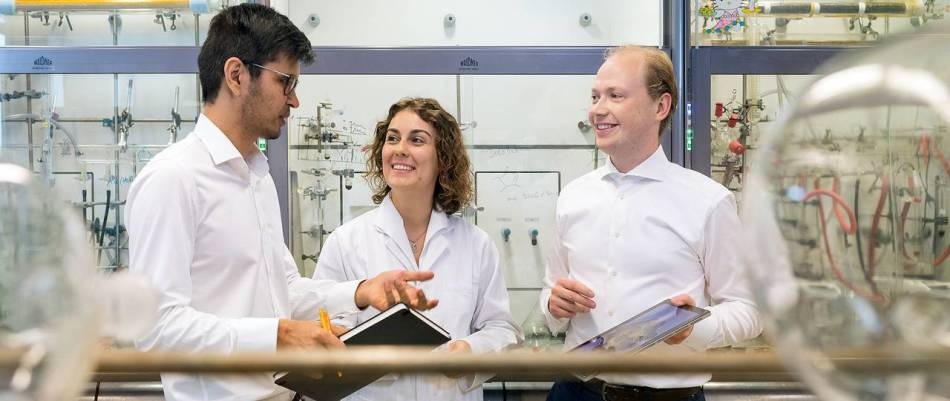Jul 4 2019
An interdisciplinary research group from the Technical University of Munich (TUM) has developed platinum nanoparticles for fuel cell catalysis. The innovative catalysts are size-optimized and are twice as good as the existing commercially available best process.
 The first authors of the project in their laboratory at the Catalysis Research Center (CRC) of TUM: Dr Batyr Garlyyev, Kathrin Kratzl, and Marlon Rück (f.l.t.r.). (Image credit: A. Eckert/TUM)
The first authors of the project in their laboratory at the Catalysis Research Center (CRC) of TUM: Dr Batyr Garlyyev, Kathrin Kratzl, and Marlon Rück (f.l.t.r.). (Image credit: A. Eckert/TUM)
Batteries may soon be replaced by fuel cells as the source of power for electric cars. They run on hydrogen, a gas which could be manufactured, for example, using extra electricity from wind power plants. However, the platinum used in fuel cells is very expensive and rare, which has been a restrictive factor in applications until now.
A research team at the Technical University of Munich (TUM) led by Roland Fischer, Professor for Inorganic and Organometallic Chemistry, Aliaksandr Bandarenka, Professor for Physics of Energy Conversion and Storage, and Alessio Gagliardi, Professor for Simulation of Nanosystems for Energy Conversion, has currently enhanced the size of the platinum particles to a great degree that the particles perform at levels twice as good as the leading processes available in the market today.
Ideal: A Platinum Egg Only 1 nm Long
In fuel cells, hydrogen reacts with oxygen to create water, producing electricity in the process. Advanced catalysts at the electrodes are necessary so as to enhance this conversion. Platinum has a key role to play in the oxygen-reduction reaction.
Pursuing a suitable solution, the team developed a computer model of the total system. The fundamental question: How small can a group of platinum atoms be and still have an extremely active catalytic effect? “It turns out that there are certain optimum sizes for platinum stacks,” explains Fischer.
Particles measuring approximately 1 nm and comprising about 40 platinum atoms are perfect.
Platinum catalysts of this order of size have a small volume but a large number of highly active spots, resulting in high mass activity.
Aliaksandr Bandarenka, Professor for Physics of Energy Conversion and Storage, University of Mainz
Interdisciplinary Collaboration
Interdisciplinary partnership at the Catalysis Research Center (CRC) was a significant factor in the research team’s outcome. Integrating theoretical skills in modeling, joint discussions, and chemical and physical insight gained from experiments eventually resulted in a model revealing how catalysts can be engineered with the ideal size, form, and size distribution of the components involved.
Furthermore, the CRC also has the know-how needed to develop and experimentally test the calculated platinum nano-catalysts. “This takes a lot in terms of the art of inorganic synthesis,” says Kathrin Kratzl, along with Batyr Garlyyev and Marlon Rück, one of the three lead authors of the study.
Twice as Effective as the Best Conventional Catalyst
The experiment precisely established the theoretical predictions. “Our catalyst is twice as effective as the best conventional catalyst on the market,” says Garlyyev, adding that this is still not satisfactory for commercial applications, since the present 50% decrease of the amount of platinum would have to increase to 80%.
Besides spherical nanoparticles, the scientists aim for even higher catalytic activity from considerably more complicated shapes. Plus, the computer models set up in the partnership are perfect for this kind of modeling. “Nevertheless, more complex shapes require more complex synthesis methods,” says Bandarenka. This will make computational and experimental studies increasingly vital in the future.